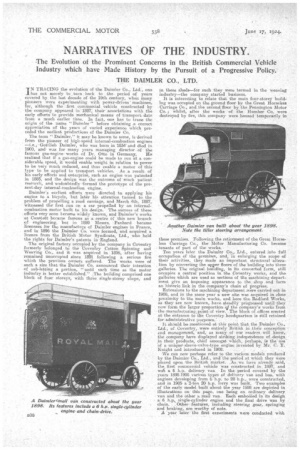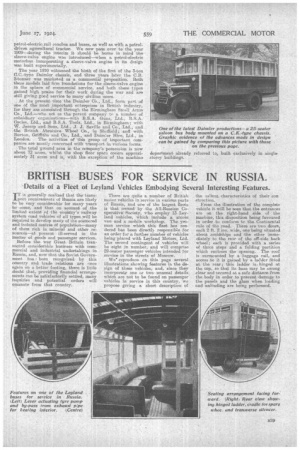NARRATIVES OF THE INDUSTRY.
Page 22

Page 23

If you've noticed an error in this article please click here to report it so we can fix it.
The Evolution of the Prominent Concerns in the British Commercial Vehicle Industry which have Made History by the Pursuit of a Progressive Policy.
THE DAIMLER CO., LTD.
JN TRACING the evolution of the Daimler Co. Ltd., one has ,not m th erely to turn hack to e period of years covered by the last decade of' the 19th century, when many pioneers were experimenting with powsr-driven machines, for although the . first commercial vehicle constructed by the company appeared in 1897, their associations with the early efforts to provide mechanical means of transport date from a much earlier time. In fact, one has to trace the origin of the name "Daimler" before obtaining .a correct appreciation of the years of varied experience which preceded the earliest productions of the Daimler Co.
'The term " Daimler," it maybe known to some, is-derived from the pioneer of high-speed internal-combustion engines —i.e., -Gottlieb Daimler, who was horn in 1834-and died in 1900, and was for many years managing director. of the famous gas-engine works of Dr. Otto in Germany. He realized that if a gas-engine could be made to run at a considerable speed, it would enable weight in relation to power to be very much reduced, and thus enable a motor of this type to be applied to transport vehicles. As a result of his early efforts and enterprise, such an engine was patented in 1885, and the design was the outcome of-much patient research, and undoubtedly /formed the prototype of the pre-, sent-day internal-combustion engine.
Daimler's earliest efforts were directed to. applying his engine to a bicycle, but later his attention turned to the problem of propelling a road carriage, and March 4th. 1887, witnessed the' first run on a car propelled by an internalcombustion motor built to his design. The success of these efforts very soon became widely •known, and Daimler's works at Canstatt became famous as a centre of this new branch of engineering, but in 1889 Messrs. -Panhard became licensees for the manufactuce of Daimler engines in France, and: in 1896 the Daimler Co. were formed, and acquired a licence from the British Motor Syndicate, Ltd., who held the rights for Daimler's patents in England. The original factory occupied by the company in Coventry formerly belong,ecl to the Coventry Cotton Spinning and Weaving Co., and it was acquired in 1896, after having remained unoccupied since 1891 following a serious fire whieh the previOns owners suffered. The works were of such a size that the Daimler Co. announced their intention of sub-letting a portion, "until such time as the motor industry is better established." The building comprised one block of four storeys, with three single-storey shops, and in these sheds—for such they were termed in the weaving industry—the company started business. It is interesting to relate that the main four-storey building was occupied on the ground floor by the Great Homeless • Carriage Co., and the second floor by the Pennington Motor Co.; whilst, after the works of the Ii umber Co. were destroyed by fire, this company were housed temporarily in these premises. Following the retirement of the Great Horseless Carriage Co. the Motor Manufacturing Co. became tenants of part of the works. Ten years later the Daimler Co., Ltd., entered into full occupation of the premises, and, in enlarging the scope of their activities. they Made an important structural alteration by cenverting the upper floors of the building into three galleries. The original building, in its converted form still occupies a central position in the Coventry works, and the galleries Which are used as sections of the machining depart. ment give an imposing appearance to the shop and form an historic link in the company's chain of program
Extensions to the machining department .were carried out in 1908, and in the same year a new site was acquired in dose proximity to the main works, and here the Radford Works, as they are now known, have ateadily progressed-until they now forth the larger proportion f the company's works from the manufacturingi.point of view. • The block of. offices erected at the entrance to the Coventry headquarters is still retained
for administrative purposes.' • • •: • ,
It shnuld be mentioned at this point that the Daimler Co., Ltd., of Coventry, were entirely British in their coneePtion and managernmat, and, as maxty of mar readers will knew, the company have displayed atrilting independence of design in their products, chief amongst which, perhaps, is the use Of a unique' sleeve-valve-type engine invented by Mr. C.-. Y. Knight and introduced in 1908.. We can now perhaps refer to the various models produced by the Daimler Co., Ltd., and 'the period at which they were placed upon the British market. As. we have already said,' the, first commercial vehicle was constructed in, 1897, and wat a 6 h.p. delivery van , In the period covered by the years 1898-1905 various types of delivery van and bus, with engines deve.haping from 6 h.p. to 28 h.p., were constructed, and in 1905 a 2-ton 20 h.p. lorry was WIC Two examples of the early Model built about the year 1898 are depicted in illu-stratiOns on this page, one being an ordinary delivery van and the other a mail van Each embodied in its design a'6 h.p,. tingle-cylinder engine and the final drive was by, chain. . Other features, including steering gear, springing and braking, are worthy of note. A year later the first experiments were conducted with petrol-electriorail coaches and buses, as well as.with a petroldriven agricultural tractor. We now pass over to the year 1909—,during the interim it should be borne in mind the sleeve-valve engine was introduced—when a petrol-electric motorbus inoorporating a sleeve-valve engine in its design was built experimentally.
The year 1910 witnessed the birth of the first of the 3-ton C.C.-type Daimler chassis, and throe years later the C.B. 2-tanner was marketed as a commercial proposition. Both these models laid firm foundations for the sleeve-valve engine in the sphere of commercial service, and both these types gained high praise for their work during the war and are still giving good service to many civilian users.
At the present time the Daimler CO., Ltd_, form part of one of the most important enterprises in British industry, for they are associated through the Birmingham Sinell Arms Co., Ltd.—who act as the parent company tn a number of subsidiary organizations—with B.S.A. Guns, Ltd. B.S.A.
lee, Ltd., and B.S.A. Tools, Ltd., in Birmingham; with JeSsop and Seas, Ltd. J. J. Saville and Co., Ltd., and the British ..kbraisive Wheel Co., in Sheffield ; and with Barton, Ceriffithrs and Co., Ltd., and Daimler Hire, Ltd., in London. The activities of this group of important companies are mostly concerned with transport in various forms.
The total ground area in the company's possession is now about 72 acres, whilst the shop floor space covers appreidmately 31 acres and is, with the exception of the machine department, already referred to, built exclusively in singlestorey buildinp.
































